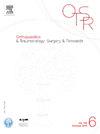治疗晚期眶管综合症时,眶管形态特征是骨间前神经充盈端到侧转移术的适应症。
IF 2.3
3区 医学
Q2 ORTHOPEDICS
引用次数: 0
摘要
背景:眶管综合征(CuTS)是一种普遍存在的压迫性神经病,可通过各种治疗方法解决,包括针对晚期 CuTS 的骨间前神经(AIN)端对端增压(SETS)转移术。增加 AIN-SETS 的决定基于各种指标和方案,但为边缘病例决定适当的方法可能具有挑战性。因此,本研究旨在利用 CT 扫描对患者的肘隧道解剖结构进行无创检查,并将检查结果与现有的指标和测量方法进行比较,以确定它们是否可作为辅助指标来帮助做出治疗决定:假设:骨性肘管容积与其他传统指标相关,可作为决定是否在治疗晚期CuTS时实施AIN-SETS的补充指标:这是一项来自韩国的单中心回顾性队列研究,包括91名年龄在20-70岁之间的CuTS患者。参与者被分为A组(43人)和B组(48人),A组同时接受了肘隧道松解术(CuTR)和AIN-SETS治疗,B组仅接受了CuTR治疗。对术前肘部 CT 数据进行了肘关节眶管形态分析,并在术后 3、6 和 12 个月进行了握力和肌电图/神经传导速度(EMG/NCV)测试等随访评估:A 组和 B 组在人口统计学参数上无明显差异,只是 A 组病程更长(p = 0.032)。与 B 组相比,A 组的肘隧道容积(CTV)更小(1150.6 ± 52.8 mm³ vs. 1173.5 ± 56.2 mm³,p = 0.014),横截面积更小(40.9 ± 10.2 mm² vs. 45.1 ± 11.7 mm²,p = 0.033)。皮尔逊相关分析显示,CTV测量结果与术前握力以及肌电图结果(AIN-SETS的关键指标)之间存在统计学意义上的显著正相关(R² = 0.48, 0.23, p = 0.01):讨论:使用CT测量肘隧道解剖结构有助于确定晚期CuTS患者的治疗方法,并帮助决定是否进行AIN-SETS手术,可作为其他指标处于边缘界限的病例的补充指标。未来的研究可能需要建立无症状对照组,并确定适当的临界值:证据等级:IV。本文章由计算机程序翻译,如有差异,请以英文原文为准。
Morphological characteristics of the cubital tunnel as indication for anterior interosseous nerve supercharge end-to-side transfer in treating advanced cubital tunnel syndrome
Background
Cubital tunnel syndrome (CuTS) is a prevalent compressive neuropathy addressed through various treatments, including the anterior interosseous nerve (AIN) supercharge end-to-side (SETS) transfer for advanced CuTS. Decision to add AIN-SETS is based on various indicators and protocols, but deciding on the appropriate method for borderline cases can be challenging. Therefore, this study aims to non-invasively examine the cubital tunnel anatomy of patients using CT scans and compare the findings with existing indicators and measurements, to determine if they can serve as supplementary indicators to aid in treatment decisions.
Hypothesis
The bony cubital tunnel volume is correlated to other traditional indicators and can be used as an additional indication for deciding whether to perform AIN-SETS in treating advanced CuTS.
Patients and Methods
This is a single-center retrospective cohort study from South Korea, including 91 patients aged 20–70 years with CuTS. Participants were classified into Group A (n = 43), who underwent both cubital tunnel release (CuTR) and AIN-SETS, and Group B (n = 48), who underwent only CuTR. Preoperative elbow CT data were analyzed for cubital tunnel morphology analysis, with follow-up assessments such as grip strength and electromyography/ nerve conduction velocity (EMG/NCV) tests at 3, 6, and 12 months postoperatively.
Results
Group A and B showed no significant differences in demographic parameters, except for a longer disease duration in Group A (p = 0.032). Group A had a smaller cubital tunnel volume (CTV) compared to Group B (1150.6 ± 52.8 mm3 vs. 1173.5 ± 56.2 mm3, p = 0.014) and a smaller cross-sectional area (40.9 ± 10.2 mm2 vs. 45.1 ± 11.7 mm2, p = 0.033). Pearson correlation analysis revealed statistically significant positive correlations between CTV measurements and pre-operative grip strength, as well as EMG results, a key indicator for AIN-SETS (R2 = 0.48, 0.23, p = 0.01).
Discussion
Measuring the cubital tunnel anatomy using CT can aid in determining the treatment approach for advanced CuTS patients and assist in deciding whether to perform AIN-SETS surgery, serving as a supplementary indicator for cases at the borderline limits of other indicators. Future research may be necessary to establish control groups without symptoms and determine appropriate cut-off values.
Level of evidence
IV.
求助全文
通过发布文献求助,成功后即可免费获取论文全文。
去求助
来源期刊
CiteScore
5.10
自引率
26.10%
发文量
329
审稿时长
12.5 weeks
期刊介绍:
Orthopaedics & Traumatology: Surgery & Research (OTSR) publishes original scientific work in English related to all domains of orthopaedics. Original articles, Reviews, Technical notes and Concise follow-up of a former OTSR study are published in English in electronic form only and indexed in the main international databases.

 求助内容:
求助内容: 应助结果提醒方式:
应助结果提醒方式:


